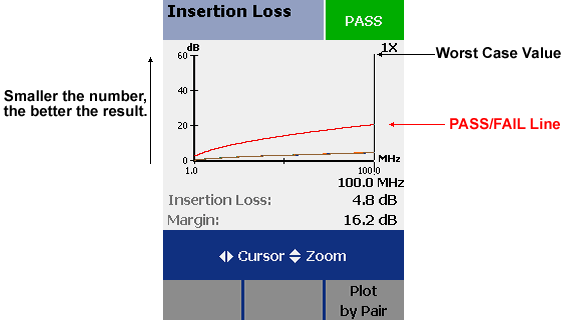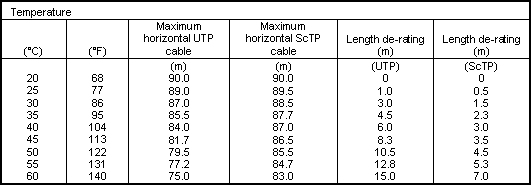Attenuation (Insertion Loss) Measurement and Testing - DTX CableAnalyzer
Standards now use the term "insertion loss" and not attenuation.
Electrical signals transmitted by a link lose some of their energy as they travel along the link. Insertion loss measures the amount of energy that is lost as the signal arrives at the receiving end of the cabling link. The insertion loss measurement quantifies the effect of the resistance the cabling link offers to the transmission of the electrical signals.

Insertion loss characteristics of a link change with the frequency of the signal to be transmitted; e.g. higher frequency signals experience much more resistance. Stated a different way, the links show more insertion loss for higher frequency signals. Insertion loss is therefore to be measured over the applicable frequency range. If you test the insertion loss of a Category 5e channel, for instance, the insertion loss needs to be verified for signals ranging from 1 MHz to 100 MHz. For Category 8 links the frequency range is 1 through 2000 MHz. Insertion loss also increases fairly linearly with the length of the link. In other words, if link "A" is twice as long as link "B", and all other characteristics are the same, the insertion loss of link "A" will turn out twice as high as the insertion loss of link "B."

Insertion loss is expressed in decibels or dB. The decibel is a logarithmic expression of the ratio of output voltage (voltage of the signal received at the end of the link) divided by input voltage (the voltage launched into the cable by the transmitter).
Results Interpretation
The insertion loss in a cable is largely dependent upon the gauge of wire used in constructing the pairs. 24 gauge wires will have less insertion loss than the same length 26 gauge (thinner) wires. Also, stranded cabling will have 20-50% more insertion loss than solid copper conductors. Field test equipment will report the worst value of insertion loss and margin, where the margin is the difference between the measured insertion loss and the maximum insertion loss permitted by the standard selected. Hence a margin of 4 dB is better than 1 dB.
Troubleshooting Recommendations
Excessive length is the most common reason for failing insertion loss. Fixing links that have failed insertion loss normally involves reducing the length of the cabling by removing any slack in the cable run.
Excessive insertion loss can also be caused by poorly terminated connectors / plugs. A poor connection can add significant insertion loss. Your clue to this cause is to compare the insertion loss on the four pairs. If only one or two pairs have high insertion loss, this suggests an installation issue. If all pairs have too much insertion loss, check for excess length. However, impurities in the copper cable can also cause insertion loss failures; again this typically happens on one pair only.
Prolonged exposure to water or excessive use of water-based cable lubricants can also increase Insertion Loss and degrade cabling performance. If cables are allowed to dry for a sufficient amount of time after excessive exposure to water, the Insertion Loss performance will typically return to normal. To avoid problems, ensure water isn’t allowed to become trapped in conduits and follow manufacturers’ instructions for the correct amount of cable lubricant to be used.
Temperature also affects insertion loss in some cables. The dielectric materials, which form the conductor insulation and cable jacket, absorb some of the transmitted signal as it propagates along the wire. This is especially true of cables containing PVC. PVC material contains a chlorine atom which is electrically active and forms dipoles in the insulating materials. These dipoles oscillate in response to the electromagnetic fields surrounding the wires, and the more they vibrate, the more energy is lost from the signal. Temperature increases exacerbate the problem, making it easier for the dipoles to vibrate within the insulation. This results in increasing loss with temperature.
For this reason, standards bodies tend to specify insertion loss requirements adjusted for 20C. Cables operating in temperature extremes can be subject to additional insertion loss and where this is likely, the design of the cabling system should take this into consideration. You may not be able to run the maximum 90 meters (295 ft) defined in the standards. Most consultants try and keep runs below 80 meters (262 ft) to provide a safety margin. This of course is not always possible when space is a premium and the number of telecommunications rooms has to be kept to a minimum. From ANSI/TIA-568-C.2 Annex G:

Some field testers have a temperature setting in them that allows you to adjust the insertion loss pass/fail line. This is not permitted in the standards. You cannot do this in any of the Fluke Networks field testers.






